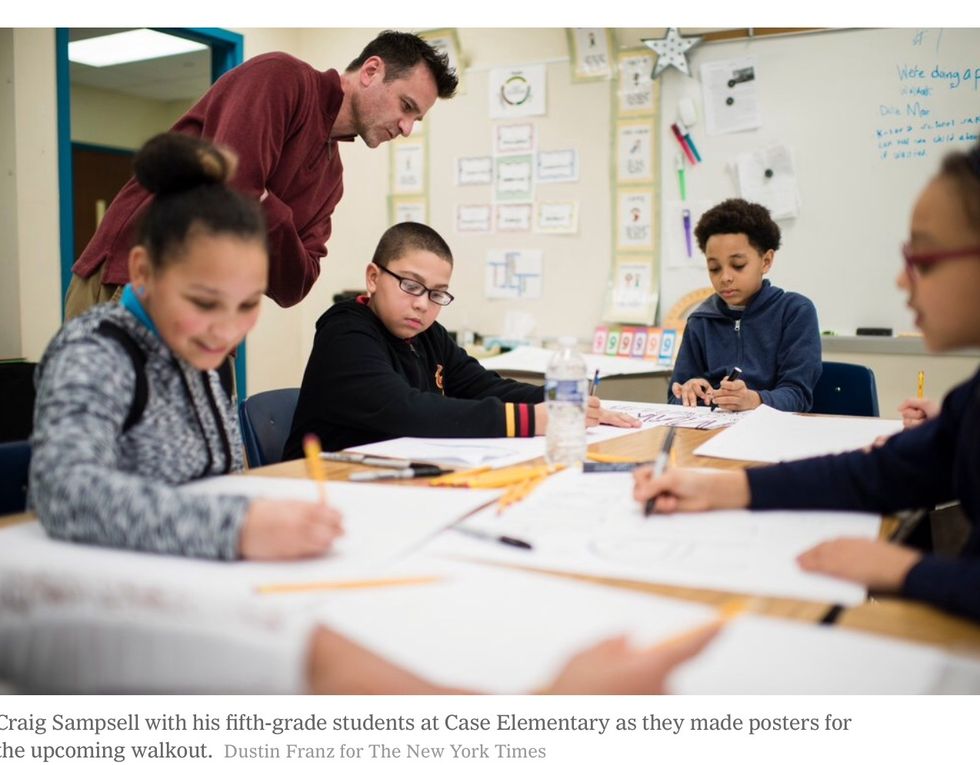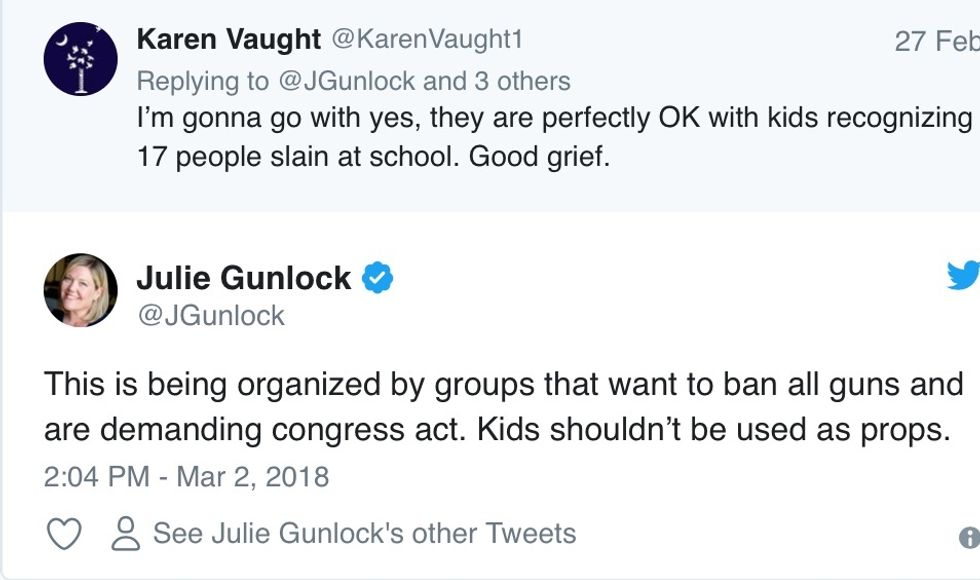It started out last month as a writing exercise on the 1963 Birmingham Children's Crusade, when more than 1,000 students skipped school and marched to demand civil rights. Then the class assignment mushroomed into a plan — hatched by 10- and 11-year-olds — to stage a little civil disobedience of their own.
So on Wednesday morning, the students in Craig Sampsell's fifth-grade class at Case Elementary School in Akron, Ohio, will pick up posters they drew and walk out of their classrooms, joining many thousands of other students in a nationwide protest against gun violence after the killing of 17 people in a Florida high school last month.
Asked whether that was an appropriate age to be protesting about a disturbing event, the principal, Danjile Henderson, said: "My fifth-grade students were very aware of the details of the events and wanted to have their own peaceful protest."
Still, she drew lines around who could participate and how. Third through fifth graders may walk out; second graders can observe the protest, but not walk; kindergartners and first-grade students will remain in their classrooms for discussions on school safety in general that avoid the shooting itself. "Not all parents may want that detailed conversation on what happened in Florida," Ms. Henderson said.
With some parents wanting their children to get firsthand exposure to a nationwide political demonstration; others worried that the protests are stoking the fears of young children about a threat that remains uncommon; and still others objecting to the gun-control message entirely, one question has been weighing heavily on school administrators this past week: How young is too young for children to join the walkout?
Many districts and schools that are tolerating, if not encouraging, participation in what organizers call the National School Walkout are also calibrating their approach for their youngest students. In New York City, middle and high school students may walk out of class with approval from a parent, such as with a permission slip, but elementary school students cannot leave unless a parent or guardian comes to check them out.
At Woods Cross Elementary School in Woods Cross, Utah, students will be allowed to leave class at 10 a.m. and go to the gym for 17 minutes, the same starting time and duration (one minute for every victim in Parkland, Fla.) as other walkouts around the country. Parents may also check them out of the school during that time, and they will not be penalized.
"We're giving them an opportunity to express their First Amendment rights in a safe place," said Rachel Peterson, a physical education teacher at the school who is also safety commissioner for the state board of the Utah PTA.
In suburban Nashville, David L. Snowden, director of schools for the Franklin Special School District, sent an email to families saying that the district had decided that it would not be appropriate for students in its elementary schools, which run through fourth grade, to participate in the walkout, but that students in grades five and up could join.
In an interview, Dr. Snowden said he was not concerned that very young children would be frightened by the walkout, only that they would not understand what it was about. "Sometimes I think when you're teaching children, especially younger children, you try to take into consideration, will there be a full understanding of what they're doing and why they're doing it," he said. "Just to walk out of class for 17 minutes, I'm not sure what that is really teaching."
Even within Akron's 50-school district, agendas for Wednesday differed markedly from school to school. At Firestone Park Elementary, students were expected to read a poem about peace. At Pfeiffer Elementary, students would be reviewing safety procedures. And at Robinson Community Learning Center there were no plans at all — students had not expressed an interest, according to the district.
Elise Cappella, a clinical psychologist and associate professor at New York University's Steinhardt School, said there was a difference between what the youngest students — from kindergarten to second grade — and older children could understand. While not advocating any particular stance, she said: "Schools could make the decision that kids in kindergarten through second grade are not provided the opportunity to walk out. They are cognitively, socially, emotionally younger. They may feel more fear about it and less understanding."
Children in the third grade and up, she said, will be more likely to be exposed to news and hear their parents talking about it. "They are reaching a point where having something that's potentially positive and productive to do that makes them feel a sense of agency and safety could be a good thing," she said.
Ms. Cappella said that whether elementary schools decided to participate in the protest or not, the goal should be to project a sense of community to their students.
"And if you can create that space," she said, "whether that's in the classroom or in the hallways or in the schoolyard or out at a protest or a march, that's the most beneficial space for young kids to be in."
Some school districts, generally in conservative areas, are trying to discourage any type of school walkout, regardless of age, warning that any student who participates will be marked as absent from class. Even some schools where demonstrations are being allowed are being careful about the tone.
Ms. Peterson, of Woods Cross in Utah, said that there was no program planned for the assembly — the students would be able to express themselves as long as they were not rowdy or disruptive. "We are teachers and not necessarily there to make a political statement in that time," she said. "Whatever is decided by students in that time and space, we will allow it to happen as long as it is peaceable and respectful."
If some students who stayed behind expressed surprise or bafflement at their classmates leaving the room, she said, teachers would use their own tact and judgment about how to explain it. "The way I would word it is that some kids are walking out to show support for lessening school violence, in honor of the people in Florida," Ms. Peterson said.
Joel Pelcyger, head and founder of the PS1 Pluralistic School, a private school in Santa Monica, Calif., consulted with parents before deciding that observing the walkout was not a political statement, but a way to empower his students and make them feel safe, regardless of age.
"The way you make people safe is by feeling that like they're part of something larger than themselves," he said.
But in Alexandria, Va., when one school decided that fifth graders could join the walkout if their parents signed them out, a parent lodged her own form of protest.
"My elementary school has 5-year-olds in it," the parent, Julie Gunlock, a senior fellow at the conservative-leaning Independent Women's Forum, said in an interview. "Some of my friends, their kids are much younger than a fifth grader. And it's frightening to them."
Maeva Lile, 11, one of the fifth-grade organizers at Case Elementary in Akron, said that most of her friends were aware of the gun-control debate and thought that AR-15s, the powerful rifle used in Parkland and other mass shootings, should not be legal. But she said her class did not want to debate the Second Amendment, and so its posters will simply honor the students killed in Parkland with their names.
Still, she thought it was time for children to do something. "Adults have been protesting against things," she said on Monday, "but nothing has changed that much."
New York Times, March 13, 2018
###
March 13, 2018



